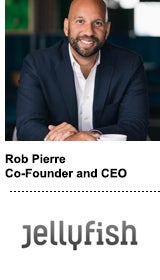When the boutique programmatic agency Jellyfish sold a majority $550 million stake last November to French holding company Fimalac, it did so to transform from an agency into a global network.
Jellyfish started as a Google Marketing Platform (GMP) reseller and programmatic in-houser. It will make this transition by acquiring specialist companies that can enhance its capabilities and footprint in regions where it doesn’t have a presence.
Jellyfish wants to compete with the big six holding companies for global accounts. But rather than going to market with multiple brands, it will operate as a single P&L under the Jellyfish brand, similar to how Accenture Interactive goes to market.
That consistency and reporting structure will give Jellyfish a leg up in rolling out a cohesive global offering, said Jellyfish CEO Rob Pierre.
“Anybody can take multiple agencies and put an umbrella brand over it and say, ‘We’ve got global coverage,’” Pierre said. “But you’re not really delivering a global solution.”
Jellyfish, which has offices in 13 countries, across the United States, Europe and Asia, has already absorbed French programmatic agency Tradelab as part of the Fimalac investment. The agency has its eye on three or four more acquisitions that will either bring in new skill sets or expand its current solutions in new markets.
Pierre spoke with AdExchanger.
AdExchanger: You say Jellyfish is better positioned than its competitors to roll out a global network. How?
ROB PIERRE: We’re not a network of multiple agencies working together. We are one brand with one proposition. We built Jellyfish from the ground up. If we acquire a business, they are fully integrated into our infrastructure.
We have heads of each capability. Their job is to ensure wherever you are, you’re using the same methodology and technology stack. If [a client’s] headquarters is in one region, we’re making sure we’ve got all of the requisite skills, products and training in that region. But if they want to export that globally, they will get the same service across the globe, and we’ll keep a centralized handle on what’s going on.
What kind of companies are you looking to acquire?
We’re looking for companies that are digital first, maybe have some technology, but more importantly, have capabilities we can integrate into what we’re doing. And, of course, if they’re in regions where we don’t have a presence.
[We’re looking for] manageable acquisitions we can integrate. [For example], we’re building out our Salesforce and CRM practice. We now have the working capital to exploit the foundations we’ve already built.
What capabilities did you gain with Tradelab?
Tradelab has programmatic and data capabilities, a reporting platform, analytics and tagging technology. They have technology that sits on top of GMP, which allows us to do more in a quicker, automated way. Jellyfish did create some tools and systems that helped us automate, but we didn’t have engineers [focused on] creating technology.
What technology do you need to build?
If we manually do anything more than three times, we want to either use technology or refine the process to make that more efficient. Setting up individual IOs in GMP could take up to 20 minutes. You have to do that quite often. So we built technology that will do it in under 60 seconds.
We’re not trying to replace the DSPs or analytics platforms. We’re building things on top that help us do things in an efficient way. We’ll go after the [products] first where we can have immediate impact. That will also help [guide] where we continue to put investment.
How is the deprecation of the cookie going to impact the work you do for clients?
It will change [how we work], because you are marketing in a different way. As the publisher and content becomes more relevant again, it’s less related to targeting the person, because you can’t get that data. We will go back to using clever ways to do contextual advertising.
I think a lot of emphasis is not going to be on the buying, but how we deliver the message with dynamic creative and the way we use different formats.
This interview has been edited and condensed.













